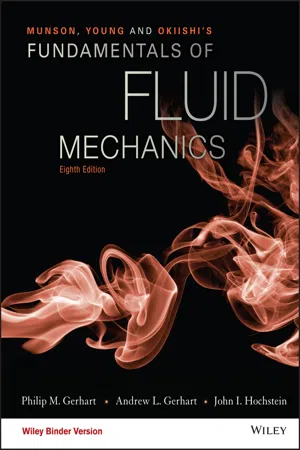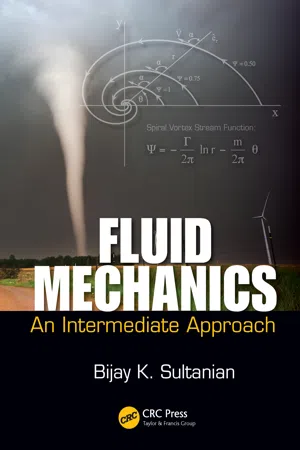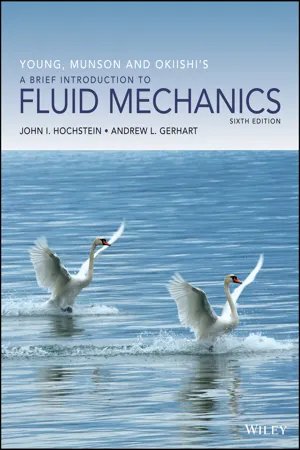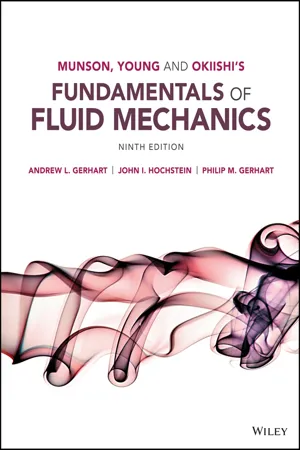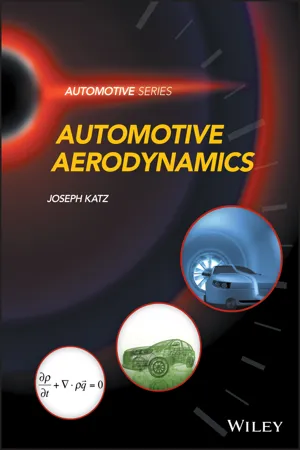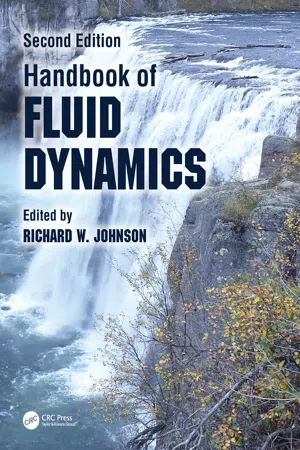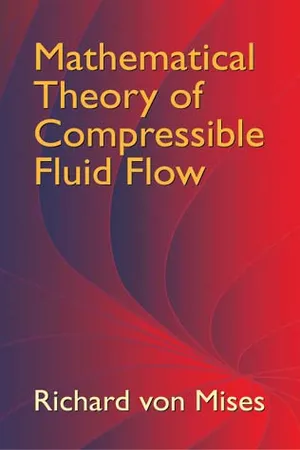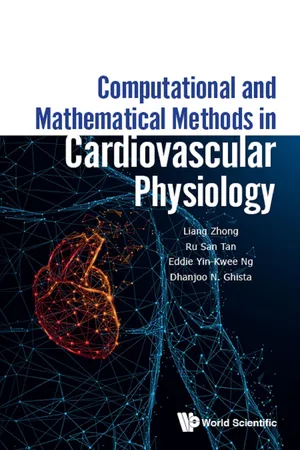Technology & Engineering
Bernoulli Equation
The Bernoulli equation, named after Swiss mathematician Daniel Bernoulli, describes the behavior of fluid flow along a streamline. It relates the pressure, velocity, and elevation of a fluid at any two points along its path. The equation is fundamental in fluid mechanics and is used to analyze and predict the behavior of fluids in various engineering applications.
Written by Perlego with AI-assistance
Related key terms
1 of 5
12 Key excerpts on "Bernoulli Equation"
- Philip M. Gerhart, Andrew L. Gerhart, John I. Hochstein(Authors)
- 2016(Publication Date)
- Wiley(Publisher)
Several applications of the Bernoulli Equation are discussed. In some flow situations, such as the use of a Pitot-static tube to measure fluid velocity or the flow of a liquid as a free jet from a tank, a Bernoulli Equation alone is sufficient for the analysis. In other instances, such as confined flows in tubes and flowmeters, it is necessary to use both the Bernoulli Equation and the continuity equation, which is a statement of the fact that mass is conserved as fluid flows. The following checklist provides a study guide for this chapter. When your study of the entire chapter and end-of-chapter exercises has been completed, you should be able to ■ write out meanings of the terms listed here in the margin and understand each of the related concepts. These terms are particularly important and are set in italic, bold, and color type in the text. ■ explain the origin of the pressure, elevation, and velocity terms in the Bernoulli Equation and how they are related to Newton’s second law of motion. ■ apply the Bernoulli Equation to simple flow situations, including Pitot-static tubes, free jet flows, confined flows, and flowmeters. ■ use the concept of conservation of mass (the continuity equation) in conjunction with the Bernoulli Equation to solve simple flow problems. ■ apply Newton’s second law across streamlines for appropriate steady, inviscid, incompress-ible flows. ■ use the concepts of pressure, elevation, velocity, and total heads to solve various flow problems. ■ explain and use the concepts of static, stagnation, dynamic, and total pressures. ■ use the energy line and the hydraulic grade line concepts to solve various flow problems. ■ explain the various restrictions on use of the Bernoulli Equation. The Bernoulli Equation is not valid for flows that involve pumps or turbines.- No longer available |Learn more
Fluid Mechanics
An Intermediate Approach
- Bijay Sultanian(Author)
- 2015(Publication Date)
- CRC Press(Publisher)
129 4 Bernoulli Equation 4.1 Introduction The original Bernoulli Equation is applicable along a streamline in an inviscid flow and between any two points in a potential flow. This equation remains one of the most used and misused equations in fluid mechanics. In this chapter, we will unravel the mystery of this equation and its various forms, including its derivations from the momentum and energy equations. This chapter also includes the extended Bernoulli Equation, which is also known as the mechanical energy equation. The engineering applications of the extended Bernoulli Equation for an incompressible flow involve frictional and other losses and shaft work trans-fer associated with pumps (energy gain by the fluid) and turbines (energy loss from the fluid). We should not use the Bernoulli Equation as a substitute for the momentum equation, including its application in the analysis of compressible flows with Mach numbers greater than 0.3. To obtain physics-based design engineering solutions, all compressible flows must be handled using the full energy equation coupled with the momentum and continuity equations. We will consider only the steady forms of the Bernoulli Equation in this book. 4.2 Original Bernoulli Equation 4.2.1 Exchange between Kinetic Energy and Potential Energy In the conservative force field of gravity, the sum of kinetic and potential energies of fluid particles in a flow with uniform static pressure remains constant. This assumes that there are no losses associated with the particle motion in the flow. This concept parallels the technique used in courses in particle physics to find, for example, the maximum height reached by a ball of mass m thrown vertically in a vacuum (no air drag) with a given initial velocity 0 V . - John I. Hochstein, Andrew L. Gerhart(Authors)
- 2021(Publication Date)
- Wiley(Publisher)
The Bernoulli Equation states that the sum of the pressure head, the velocity head, and the elevation head is constant along a streamline. The constant is called the total head. The Bernoulli Equation can be written in terms of heights called heads. EXAMPLE 3.4 Kinetic, Potential, and Pressure Energy Given Consider the flow of water from the syringe shown in Fig. E3.4a. As indicated in Fig. E3.4b, a force, F, applied to the plunger will produce a pressure greater than atmospheric at Find Discuss the energy of the fluid at points (1), (2), and (3) by using the Bernoulli Equation. point (1) within the syringe. The water flows from the needle, point (2), with relatively high velocity and coasts up to point (3) at the top of its trajectory. Solution If the assumptions (steady, inviscid, incompressible flow) of the Bernoulli Equation are approximately valid, it then follows that the flow can be explained in terms of the partition of the total energy of the water. According to Eq. 3.7, the sum of the three types of energy (kinetic, potential, and pressure) or heads (velocity, elevation, and pressure) must remain constant. The table indicates the relative magnitude of each of these energies at the three points shown in the figure. The motion results in (or is due to) a change in the mag- nitude of each type of energy as the fluid flows from one location to another. An alternate way to consider this flow is (a) g F (1) (2) (3) (b) FIGURE E3.4 Energy Type Point Kinetic V 2 /2 Potential g z Pressure p/ρ 1 Small Zero Large 2 Large Small Zero 3 Zero Large Zero Bruce Munson 82 CHAPTER 3 Elementary Fluid Dynamics—The Bernoulli Equation When a fluid particle travels along a curved path, a net force directed toward the center of curvature is required. Under the assumptions valid for Eq. 3.12, this force may be either gravity or pressure, or a combination of both.- Andrew L. Gerhart, John I. Hochstein, Philip M. Gerhart(Authors)
- 2021(Publication Date)
- Wiley(Publisher)
With the appropriate restrictions, the general energy equation reduces to the Bernoulli Equation. This approach is discussed in Sections 5.3.3 and 5.4. An alternate but equivalent form of the Bernoulli Equation is obtained by dividing each term of Eq. 3.7 by the specific weight, γ, to obtain p _ γ + V 2 _ 2 g + z = constant on a streamline Each of the terms in this equation has the units of energy per weight (LF/F = L) or length (feet, meters) and represents a certain type of head. The elevation term, z , is related to the potential energy of the particle and is called the elevation head. The pressure term, p/γ, is called the pressure head and represents the height of a column of the fluid that is needed to produce the pressure p. The velocity term, V 2 /2g, is the velocity head and represents the vertical distance needed for the fluid to fall freely (neglecting friction) if it is to reach velocity V from rest. The Bernoulli Equation states that the sum of the pressure head, the velocity head, and the elevation head is constant along a streamline. The constant is called the total head. The Bernoulli Equation can be written in terms of heights called heads. EXAMPLE 3.4 Kinetic, Potential, and Pressure Energy Given Consider the flow of water from the syringe shown in Fig. E3.4a. As indicated in Fig. E3.4b, a force, F, applied to the plunger will produce a pressure greater than atmospheric at Find Discuss the energy of the fluid at points (1), (2), and (3) by using the Bernoulli Equation. point (1) within the syringe. The water flows from the needle, point (2), with relatively high velocity and coasts up to point (3) at the top of its trajectory. Solution If the assumptions (steady, inviscid, incompressible flow) of the Bernoulli Equation are approximately valid, it then follows that the flow can be explained in terms of the partition of the total energy of the water.- Andrew L. Gerhart, John I. Hochstein, Philip M. Gerhart(Authors)
- 2023(Publication Date)
- Wiley(Publisher)
With the appropriate restrictions, the general energy equation reduces to the Bernoulli Equation. This approach is discussed in Section 5.3.3. An alternate but equivalent form of the Bernoulli Equation is obtained by dividing each term of Eq. 4.7 by the specific weight, γ, to obtain p _ γ + V 2 _ 2 g + z = constant on a streamline Each of the terms in this equation has the units of energy per weight (LF/F = L) or length (feet, meters) and represents a certain type of head. The elevation term, z , is related to the potential energy of the particle and is called the elevation head. The pressure term, p/γ, is called the pressure head and represents the height of a column of the fluid that is needed to produce the pressure p. The velocity term, V 2 /2g, is the velocity head and represents the vertical distance needed for the fluid to fall freely (neglecting friction) if it is to reach velocity V from rest. The Bernoulli Equation states that the sum of the pressure head, the velocity head, and the elevation head is constant along a streamline. The constant is called the total head. The Bernoulli Equation can be written in terms of heights called heads. EXAMPLE 4.4 Kinetic, Potential, and Pressure Energy Given Consider the flow of water from the syringe shown in Fig. E4.4a. As indicated in Fig. E4.4b, a force, F, applied to the plunger will produce a pressure greater than atmospheric at point (1) within the syringe. The water flows from the needle, point (2), with relatively high velocity and coasts up to point (3) at the top of its trajectory. Find Discuss the energy of the fluid at points (1), (2), and (3) by using the Bernoulli Equation. Solution If the assumptions (steady, inviscid, incompressible flow) of the Bernoulli Equation are approximately valid, it then fol- lows that the flow can be explained in terms of the partition of the total energy of the water.- eBook - ePub
- Alan C. Twort, Don D. Ratnayaka, Malcolm J. Brandt(Authors)
- 2000(Publication Date)
- Butterworth-Heinemann(Publisher)
where HL is the energy head lost by the water flowing from A to B. Hence:((12.2)) This is the general form of the energy equation; it is fundamental to almost all hydraulic calculations and is referred to several times below. This general energy equation is also referred to as the modified Bernoulli Equation. Bernoulli's equation itself, which is one of the most widely quoted equations in fluid dynamics, is a particular case of this general energy equation in which there is no energy loss between points 1 and 2. Bernoulli's equation is:The limitations of Bernoulli's equation must be carefully noted. It applies only to steady flow within a streamline and to flow where no energy is lost through turbulence. Therefore, it can only be applied as an approximation over short distances. In all civil engineering applications energy is lost as flow moves from point A to point B and the challenge is the determination of this loss.12.2 Boundary LayersThe concept of streamlines is most relevant to the idealized condition of flow moving uniformly in a large body of water. Away from the influence of any solid boundary, a particle of water follows its streamline, a condition known as potential flow. However, when a boundary is introduced into the flow the water in immediate contact with the solid surface must be stationary. Away from the surface the velocity increases up to a point where the flow is unaffected by the surface boundary. In this region adjacent to the surface there is a varying velocity gradient, with adjacent streamlines at different velocities. This region is known as the boundary layer. The thickness of the boundary layer depends on a number of factors but the boundary layer can be envisaged as growing from the point of contact of the flow with the solid boundary. In a conduit of finite size the boundary layer increases in the direction of flow until it fills the full depth of flow in an open channel or the full cross-section of a pipe. - eBook - ePub
- Joseph Katz(Author)
- 2016(Publication Date)
- Wiley(Publisher)
Of course, in reality the flow could have a much more complex three-dimensional velocity distribution. Figure 3.1 One- and two-dimensional velocity distributions The basic equations used for such one-dimensional flows are the integral form of the continuity and momentum equations (as developed in Section 2.6). However, an additional equation, called the Bernoulli Equation, is frequently used and therefore we must derive it first. 3.2 The Bernoulli Equation In the earlier discussion about the kinetic theory of gases (see Fig. 1.17), we speculated how Daniel Bernoulli connected (in the mid-1700s) velocity with pressure variations in a moving fluid. This equation is widely used in numerous engineering applications, but it is initially limited to flows without friction (this can be modified later by including a head loss term). The objective of this section is to introduce the Bernoulli Equation for inviscid flows, and a more detailed discussion of its limitation will follow in Section 6.3. To clarify the applicability of this equation, consider the flow over a moving vehicle, as shown in Fig. 3.2. We may follow a particle moving along a streamline as shown, but we assume that there are no losses such as friction along this path. This assumption suggests that we must use the inviscid form of the momentum equation (Eq. 2.41), called the Euler equation. (2.41) Figure 3.2 Frictionless flow along a streamline The x component of the Euler equation may be rewritten (recall that the discussion is on one-dimensional flow only) as: (3.1) The only body force we consider for this case is gravity, which acts in the vertical direction: The negative sign reflects that gravity acts opposite to the z (or h) direction. This force is conservative and the work along the streamline depends only on h. Consequently we can write that the force is a gradient of a conservative potential (− gh) Again, note that here (see Fig - Ahlam I. Shalaby(Author)
- 2018(Publication Date)
- CRC Press(Publisher)
4.5.3The Bernoulli EquationApplication of the energy equation for incompressible, steady, and ideal flow results in the definition of the Bernoulli Equation. The viscosity of real flow (a real fluid) introduces a great complexity in a fluid flow situation, namely friction due to the viscous shearing effects. The assumption of ideal flow (inviscid flow) assumes an ideal fluid that has no viscosity and thus experiences no shear stresses (friction) as it flows. Although this is an idealized flow situation that does not exist, such an assumption of ideal flow produces reasonably accurate results in flow systems where friction does not play a significant role. In such ideal flow situations, energy losses that are converted into heat due to friction represent a small percentage of the total energy of the fluid flow. Examples of situations where the assumption of ideal flow include fluids with a low viscosity, where the pipe or channel lengths are relatively short and the pipe diameters and the valve and fitting sizes are large enough to sufficiently handle the discharges. In an ideal flow situation, because there is no friction (μ = 0 and thus τ = 0), flow energy (flow work, or pressure energy) is converted to kinetic energy (or vice versa), with no energy lost to heat.As noted above, while the energy equation derived based on the conservation of momentum principle given by Equation 4.44 does not consider the modeling of energy transfer by work (pumps, turbines, etc.), the energy equation derived based on the conservation of energy principle given by Equation 4.181- eBook - PDF
- Richard W. Johnson(Author)
- 2016(Publication Date)
- CRC Press(Publisher)
∂ + + + + ∂ ∂ φ θ λ θ μ θ θ θ θ φ u r u r r r u r cot cot sin sin div u + ∂ ∂ 1 r u sin θ φ θ (4.89) where div u = ∂ ∂ ( ) + ∂ ∂ + ∂ ∂ 1 1 1 2 2 r r r u r u r u r sin ( sin ) sin θ θ θ θ φ θ φ (4.90) 4.1.6 Bernoulli Equations The Bernoulli Equations are mechanical energy equations that can be obtained from the energy equation (Panton, 1984) for an inviscid flow with a conservative body force, or by integrating the inviscid momentum equation (Euler equation) in the stream direction. They are first integrals of the equations of motion. The conservative body force is assumed to be given by Equation 4.5. Various forms of the Bernoulli Equation are listed below, along with the assumptions under which each form is valid. Other forms are given in standard texts (Yih, 1969; Panton, 1984). In the following equations, q 2 = u · u is the square of the magni-tude of the total velocity. 1. Steady flow, valid along a streamline dp q gz C ρ ψ + + = ∫ 2 2 ( ) (4.91) where C ( ψ ) is a constant that can vary from one stream-line to another; if ω × u = 0 and the flow is homentropic, then, this equation is valid everywhere. 2. Unsteady, irrotational flow, ω = curl u = 0, u = grad Φ , ∂ ∂ + + + = ∫ Φ t dp q gz K t ρ 2 2 ( ) (4.92) where K ( t ) is a constant that can vary with time and Φ is the velocity potential; for steady flow, the constant is the same everywhere. 3. Steady flow with respect to a frame rotating with a con-stant angular velocity Ω about the z -direction, using polar cylindrical coordinates ( r , θ , z ) dp q gz r C ρ ψ + + -= ∫ 2 2 2 2 2 Ω ( ) (4.93) where C ( ψ ) is a constant that can vary from one stream-line to another. For a perfect gas dp p ρ γ γ ρ = -∫ 1 (4.94) while for an incompressible fluid, the integral in Equation 4.94 is p / ρ . - David R. Gaskell, Matthew John M. Krane(Authors)
- 2024(Publication Date)
- CRC Press(Publisher)
sum of the work done on the fluid and the changes in kinetic and potential energies do not vary along that continuous path:(6.3)+(2P ρ)1 2+ gv ¯2 2z 2=+(1P ρ)1 2+ gv ¯1 2z 1=C B,where CB is a constant.In this development of Bernoulli’s equation, we have neglected several possible physical phenomena. The density is assumed to be not a function of pressure, which is valid for liquids or if the change in the pressure in a gas is small enough. (This approximation is reasonable in most applications in materials processing; supersonic flow in an oxygen lance during oxygen steelmaking is one exception.) A steady flow has been assumed, so no work must be done (or recovered) from an acceleration (or deceleration) of the fluid. No work or heat has been directly added to the system, except due to the imposed pressure difference between points 1 and 2, and we have neglected any friction in the conduit.Using the average velocity in the pipe, v̄, we may obtain the volume flow rate (Q) in the pipe,Q =(6.4)v ¯A ,where A is the cross-sectional area perpendicular to the flow direction and Q has units of m3 /s. The mass flow rate in the pipe, ṁ, is the product of the volume flow rate and the fluid density,(6.5)m ˙= ρ Q ==(1ρ)v ¯A(2ρ)v ¯Awhere conservation of mass requires ṁ in and out of the pipe be the same, assuming no accumulation of fluid.In any real system, the second law of thermodynamics requires that some of the mechanical energy be degraded to thermal energy due to the friction in the moving fluid. The existence of this effect means that the Bernoulli Equation, Eqs. (6.2) and (6.3), is not strictly valid, i.e., CB in Eq. (6.3) is not a constant. Eq. (6.2) must be modified to account for the dissipation of energy caused by the viscous drag exerted on the flowing fluid by the tube wall. If, between planes 1 and 2, this quantity, which is termed the friction loss, is ef- eBook - ePub
- Richard von Mises(Author)
- 2013(Publication Date)
- Dover Publications(Publisher)
-relation the sum H of the velocity head, the geometrical elevation, and the pressure head, has a constant value for each particle. For all particles on the same streamline this constant is the same. The quantity H is known as the total head or as the Bernoulli constant or the Bernoulli function (since it may vary from one streamline to the next).11The Bernoulli Equation can also be given in differential form, by multiplying through by dt in Eq. (18):(21)or, neglecting gravity,(21′)where the differentials refer, of course, to the changes in q, h, and p for a definite particle.The Bernoulli Equation in differential form can also be derived directly from Eq. (1.I) as the component of Newton’s equation in the direction of q, where d/dt is to be identified with q(∂/∂s).For the four cases listed previously, the function P is given by- Incompressible flow, or ρ = ρ 0 :
- Isothermal flow of a perfect gas, or
(22)
- Polytropic flow, or :
- Linearized condition, ρ = :
If the Bernoulli Equation (20) is compared with the energy equation (16) for an elastic fluid, it is seen that P includes both the strain energy and the surface work w. In fact, the equalityfollows for steady motion directly from (4), using (15), (5), and (19). Thus the pressure head P/g is not an energy, but the sum of an energy term and a work term.In thermodynamics the sum of internal energy U plus the quotient p/p is known as enthalpy:(23)In adiabatic flow, where Q′ = 0, it follows from Eq. (10) thatsince each particle possesses a (p, ρ )-relation expressed by the constancy of its entropy. Thus, the quantity P in the case of adiabatic flow differs from the enthalpy I only by an additive constant (which still may be different for each particle). If the motion is isentropic, P as well as I is an over-all function of the state variables, and in this case they differ by an over-all constant.6. Two integral theorems
- Liang Zhong, Ru San Tan;Eddie Yin Kwee Ng;Dhanjoo N Ghista(Authors)
- 2019(Publication Date)
- WSPC(Publisher)
This assumption is usually based on using dimensional analysis to compare the viscous term in the Navier–Stokes equation to the other terms and neglecting the viscous term. In this regard, let us consider the influence of the Reynolds number Re = ρ LU / μ, where L is the characteristic length scale and U is the characteristic velocity scale. So for example, if the Reynolds number is sufficiently large, viscous contributions can be considered negligible in the bulk flow, although they still are important in the viscous boundary layer near boundaries. The momentum equation for an inviscid fluid is known as the Euler equation, and is given by: If we consider the flow to be steady, inviscid, and incompressible, and then integrate between two points on the same streamline, we obtain what is known as the Bernoulli Equation: where points 1 and 2 are on the same streamline, V is velocity, z is elevation, and γ = ρg is the specific weight of the fluid. The subscripts denote points 1 and 2. Note that streamlines are lines that are everywhere tangential to the velocity field. The Bernoulli Equation is usually applied between two points, where one of the points is a location at which we wish to determine either pressure or velocity and the other is a location where the values are known. This type of analysis is often simpler than considering the entire velocity and pressure fields, i.e., the values at all locations, as in the more general Navier–Stokes equation. 4.2.4 Stream function and velocity potential Streamlines are useful in visualizing the flow field. In the case of 2D flow, we can define a stream function, ψ, such that the continuity equation is satisfied for any stream function
Index pages curate the most relevant extracts from our library of academic textbooks. They’ve been created using an in-house natural language model (NLM), each adding context and meaning to key research topics.
